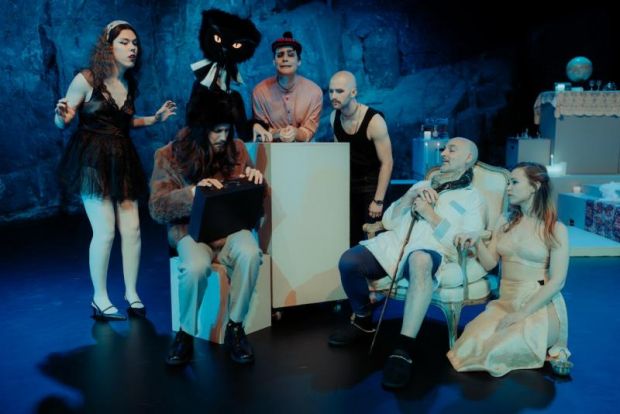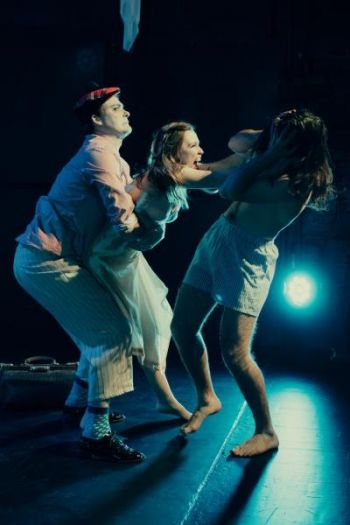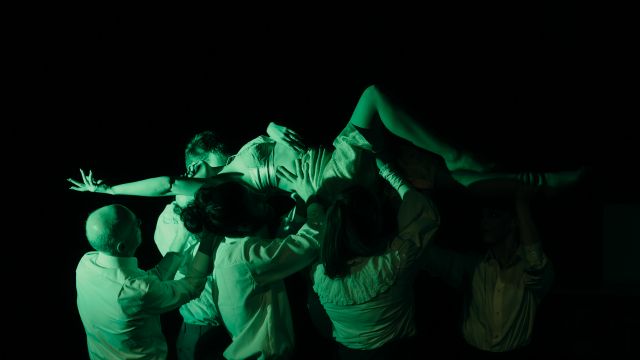The Master and Margarita
There are many ways to kill a play; a bad review, a lack of funding or unambitious management, for example. We are accustomed to this occurring. This play recalls (or anticipates) a time when ideas are considered simply Wrong or Fake, and truths are rewritten by those in power, their originators removed from society. Implausible now, but common in the early C20th Soviet Union in which The Master and Margarita is set.
 The Master and Margarita is both a novel by Russian Mikhail Bulgakov (first written in 1928 and finally published in its complete and uncensored form in 1973) and also a 2004 play written by Edward Kemp. In both stories there are two timelines – Jerusalem in the first Century AD and early C20th Moscow. The play is long and episodic, but engaging, in the manner of an epic adventure or a fable. The scope is vast, the characters numerous and the style variously dark and satirical, surreal and dialectical.
The Master and Margarita is both a novel by Russian Mikhail Bulgakov (first written in 1928 and finally published in its complete and uncensored form in 1973) and also a 2004 play written by Edward Kemp. In both stories there are two timelines – Jerusalem in the first Century AD and early C20th Moscow. The play is long and episodic, but engaging, in the manner of an epic adventure or a fable. The scope is vast, the characters numerous and the style variously dark and satirical, surreal and dialectical.
The Jerusalem plot is a play-within-a-play, the story that came to its author (the fictional character, Master) in a dream. The Master and Margarita begins and ends with Pilate, returning frequently to the many compelling philosophical exchanges between he and Jesus. Pilate, played with gravitas and veracity by Paul McNally, is greatly conflicted because of his reluctance to execute Jesus. The Master, who has authored these play-within-a-play exchanges, postulates that if Pilate could continue the debate indefinitely, in respectful dialogue, Jesus would not have had to die. This is in contrast to the repressive Communist regime in which the Master lives and works where ideas are repressed and the progenitor of such ideas is executed.
The Moscow timeline is therefore semi auto biographical. Bulgarov and his fictional character, The Master, are victims of a cabal of censors and administrators. Both had works banned, censored and, in Bulgakov’s own words, “killed”. Bulgakov, the writer, and the fictional Master, both burn their magnum opus. Both have well founded fears for their personal safety. Inevitably The Master and Margarita was construed at its time of writing as a critique of political repression and contemporary society, a society in which individuals might be (and are) betrayed to authority for personal gain.
In addition to this play-within-a-play, is another element. Satan and his entourage are visitors to atheist Moscow, evidently to host a seasonal ball but also to exact revenge upon the Master’s antagonists. The audience is meant to accept the plausibility of this troupe: Satan, aka Professor Woland, his talking cat (Behemoth), his vampire servant (Hella), the muscle-bound minion (Azazello) and comic sidekick (Koroviev). When events are concluded, the inhabitants of Moscow all agree that they have been subject to some mass hallucination and the truth of what has transpired is rewritten to reflect the official party line. History is revised.

Seventeen actors bring this extraordinary epic to life, often playing multiple characters, necessitous of quick changes, physical skill, stamina and versatility. There are many enjoyable performances.
Peter Brown is tender, funny and a core presence as the Master. Jess King, as Margarita, is beautifully dressed - and undressed. Her skin cream transformation is a charming piece of stage magic. She, like Brown, has a broad range of performance. The handkerchief scene was genuinely moving.
 Andromeda Smith develops Ivan into something quite interesting and complex with some powerful moments near the end of the play. Steven Jones is an ideal casting choice as Satan in his various aspects (traveller, magician, host etc). Jones, in some wonderful coats, is supported by an athletic Laura White as the cat, Behemoth. The cat’s head by Fran Reeve is an adjunct to White’s own facial expression and sinuous physicality. Inigo Wadsley is a terrifying Ratslayer (the executioner) but has some charm as the Puckish but weirdly aracedine messenger, Azazello. Wadsley creeps and crouches in an unsettling manner. Joshua Scott is riveting as Koroviev; attractive and repulsive, hilarious and confusing. He also has a wonderfully evil moment as President of the Sanhedrin. Steph Francis gives a quirky Stravinsky (the psychiatrist) and Bryan Stephens epitomises the (Western) conception of Jesus.
Andromeda Smith develops Ivan into something quite interesting and complex with some powerful moments near the end of the play. Steven Jones is an ideal casting choice as Satan in his various aspects (traveller, magician, host etc). Jones, in some wonderful coats, is supported by an athletic Laura White as the cat, Behemoth. The cat’s head by Fran Reeve is an adjunct to White’s own facial expression and sinuous physicality. Inigo Wadsley is a terrifying Ratslayer (the executioner) but has some charm as the Puckish but weirdly aracedine messenger, Azazello. Wadsley creeps and crouches in an unsettling manner. Joshua Scott is riveting as Koroviev; attractive and repulsive, hilarious and confusing. He also has a wonderfully evil moment as President of the Sanhedrin. Steph Francis gives a quirky Stravinsky (the psychiatrist) and Bryan Stephens epitomises the (Western) conception of Jesus.
The complement of performers all took individual characters but worked very well together as an ensemble, e.g. in the ball room scene, magic scene, and the cabal of critics. There are many clever surprises of choreography, lighting, costume, sound, set and properties that enable to story to proceed with pace and interest. The show is a spectacle, a parade of improbable events, but with clear directorial vision across the styles depicted. The musical sound track was similarly curious, eclectic and well-considered.
This play is long; nearly three hours of madness. But it is a cathartic kind of madness. Ideas cannot be stamped out by tyrants or fools and there is peace for those who have courage.
Anne Blythe-Cooper
Subscribe to our E-Newsletter, buy our latest print edition or find a Performing Arts book at Book Nook.

